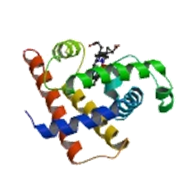BDBM24627 1H-indazole::Indazole, 5::Indazole, 6
SMILES c1n[nH]c2ccccc12
InChI Key InChIKey=BAXOFTOLAUCFNW-UHFFFAOYSA-N
Activity Spreadsheet -- Enzyme Inhibition Constant Data from BindingDB
 Found 4 hits for monomerid = 24627
Found 4 hits for monomerid = 24627
Affinity DataKd: 1.00E+6nMAssay Description:The thermal-shift denaturation assay was performed on an iCycler iQ Real Time Detection System (BioRad) in 96-well iCycler iQ PCR plates sealed with ...More data for this Ligand-Target Pair
Affinity DataKd: 3.60E+5nMAssay Description:Binding affinity to recombinant ferric state of IDO1 (unknown origin) expressed in Escherichia coli assessed as dissociation constant incubated for 3...More data for this Ligand-Target Pair
Affinity DataKd: 5.30E+3nMAssay Description:Binding affinity to human HSP90alpha assessed as 2D1H-15N chemical shift perturbation by NMR spectroscopyChecked by AuthorMore data for this Ligand-Target Pair
Affinity DataKd: 8.10E+4nMAssay Description:Binding affinity to recombinant ferrous state of IDO1 (unknown origin) expressed in Escherichia coli assessed as dissociation constant incubated for ...More data for this Ligand-Target Pair

 3D Structure (crystal)
3D Structure (crystal)